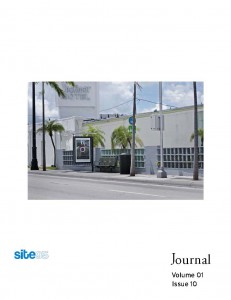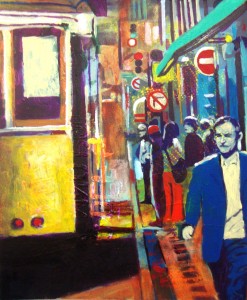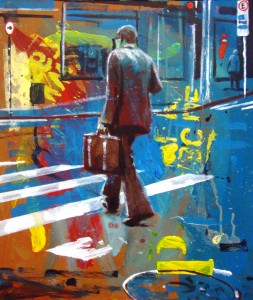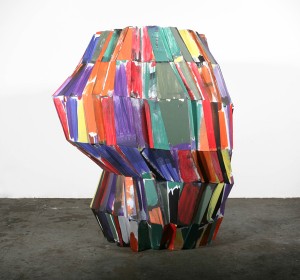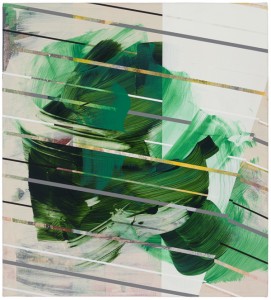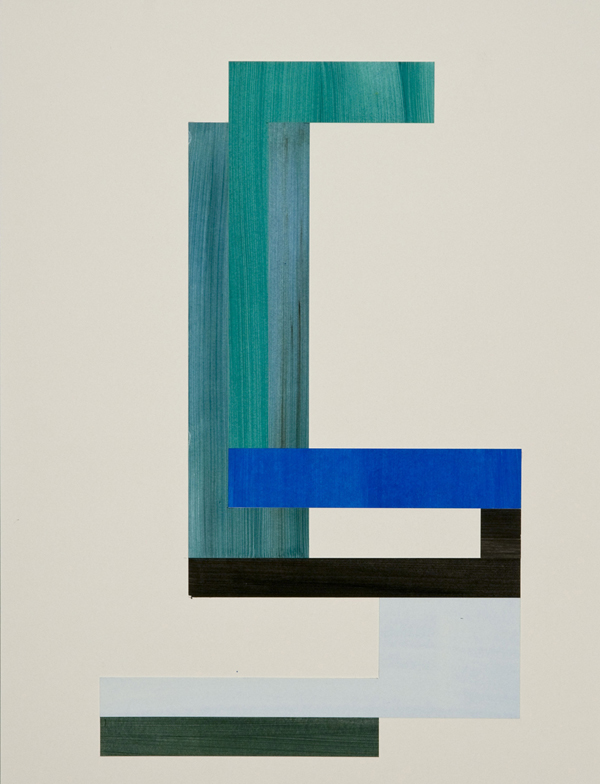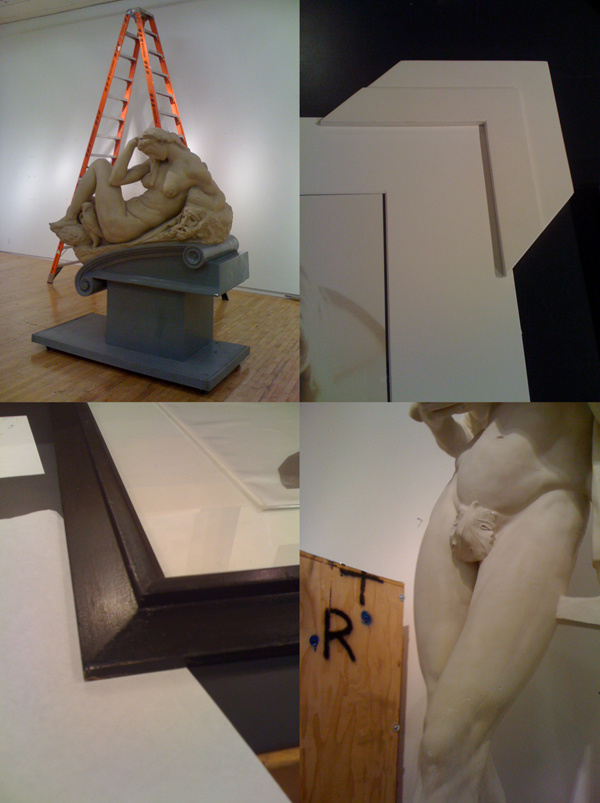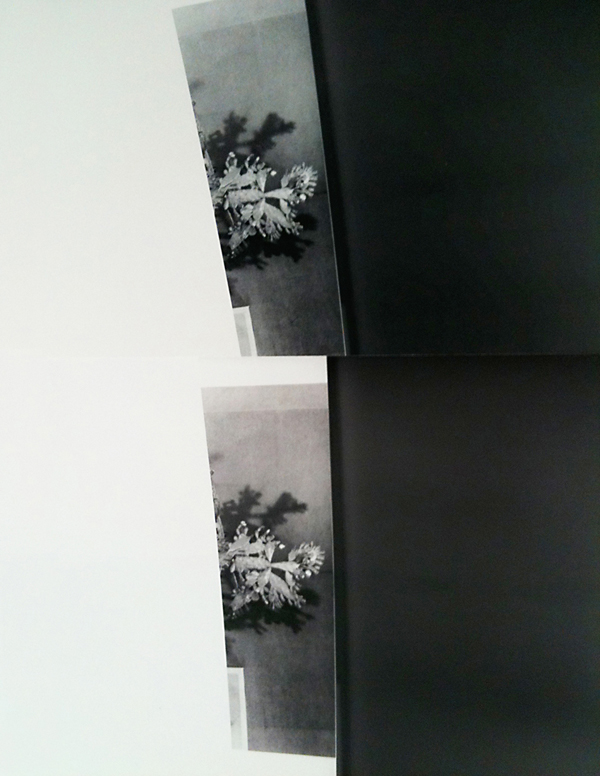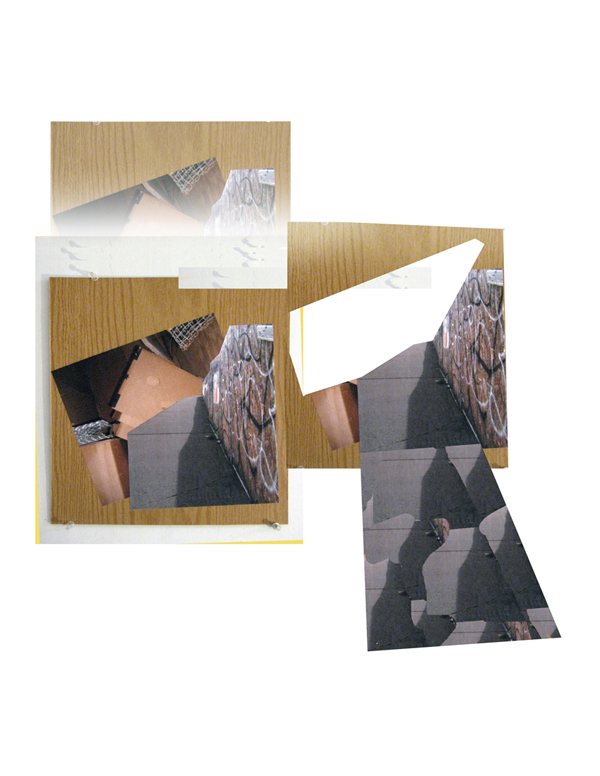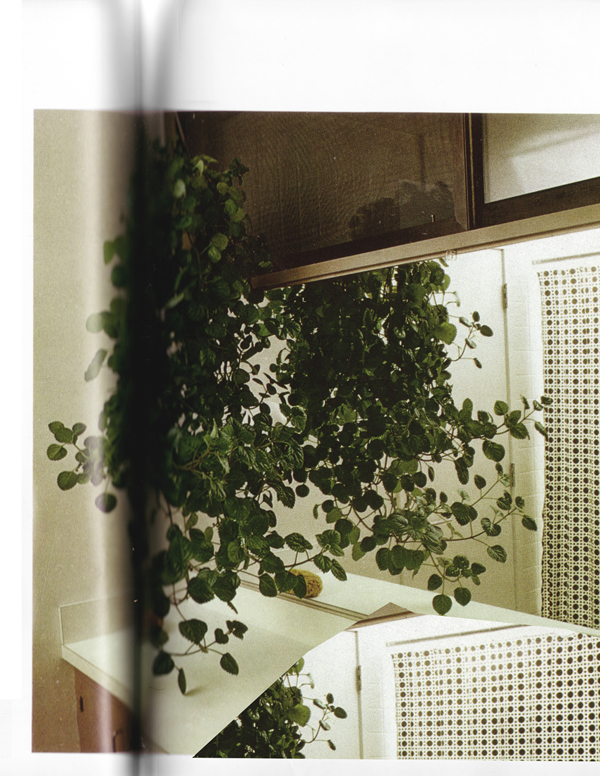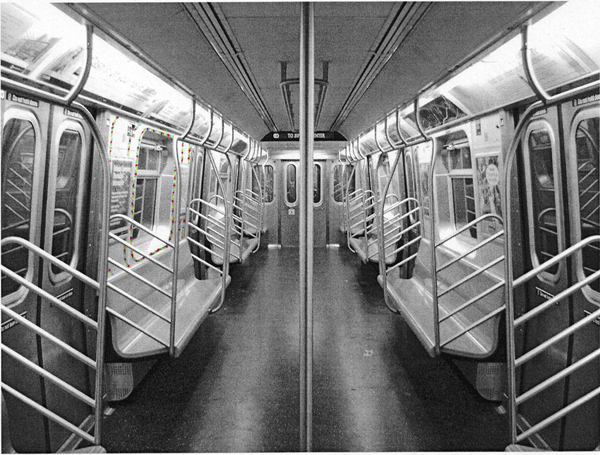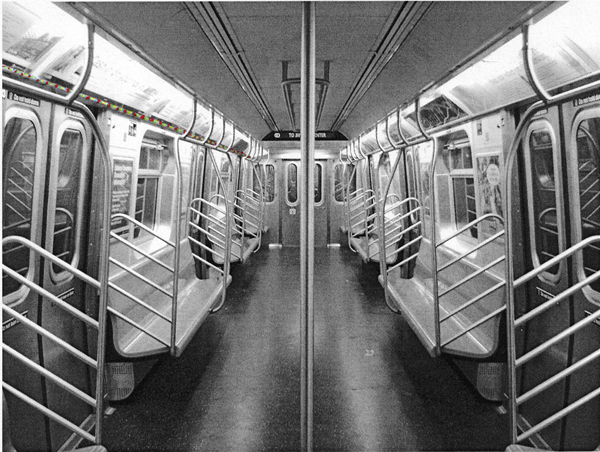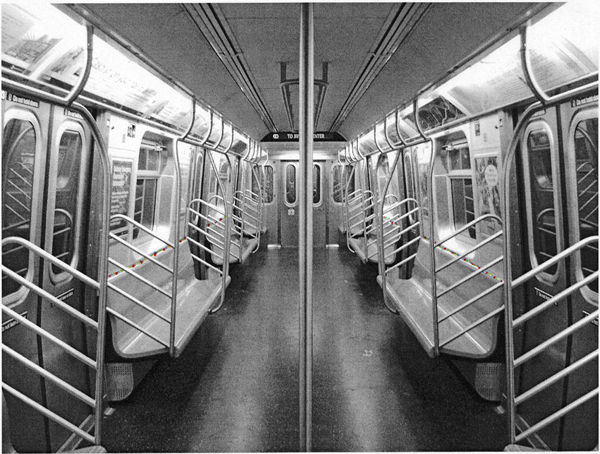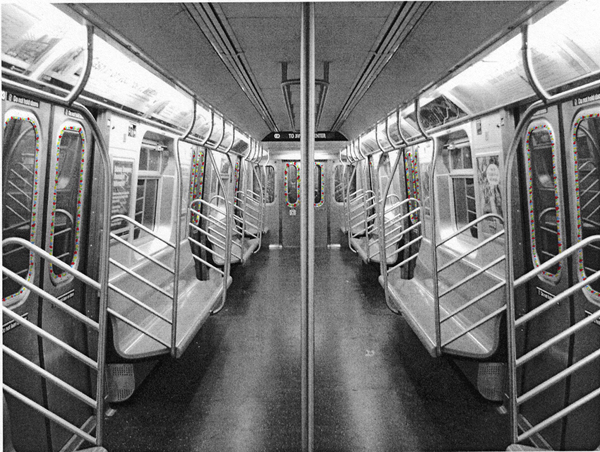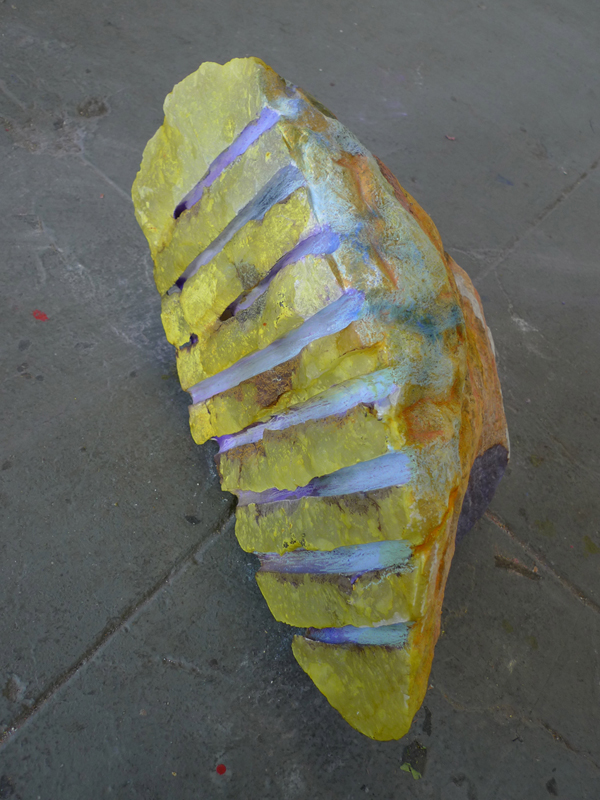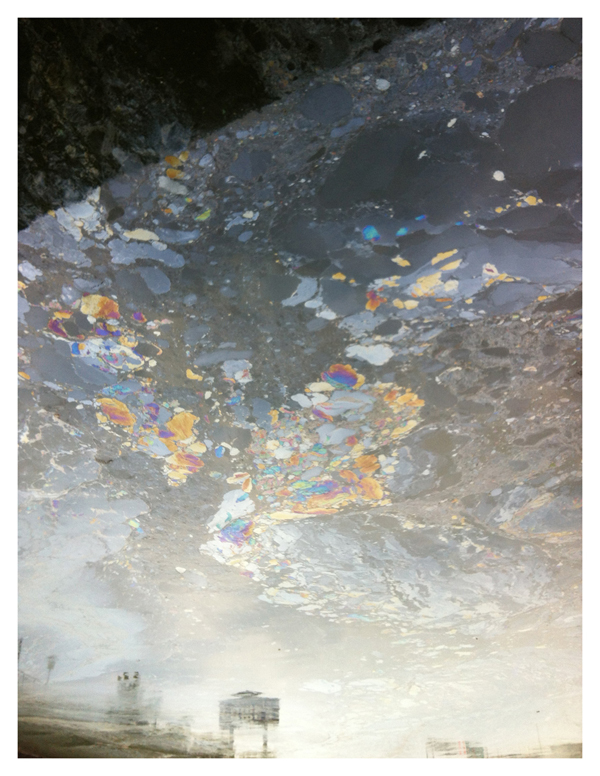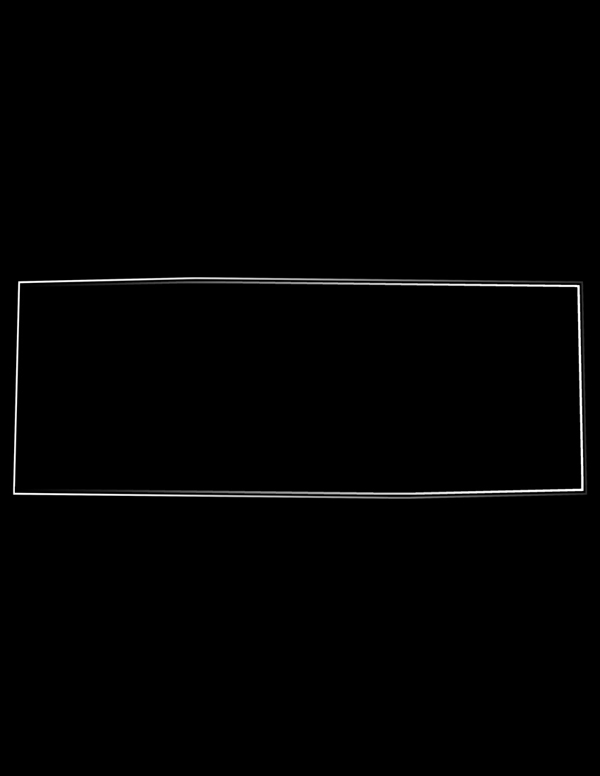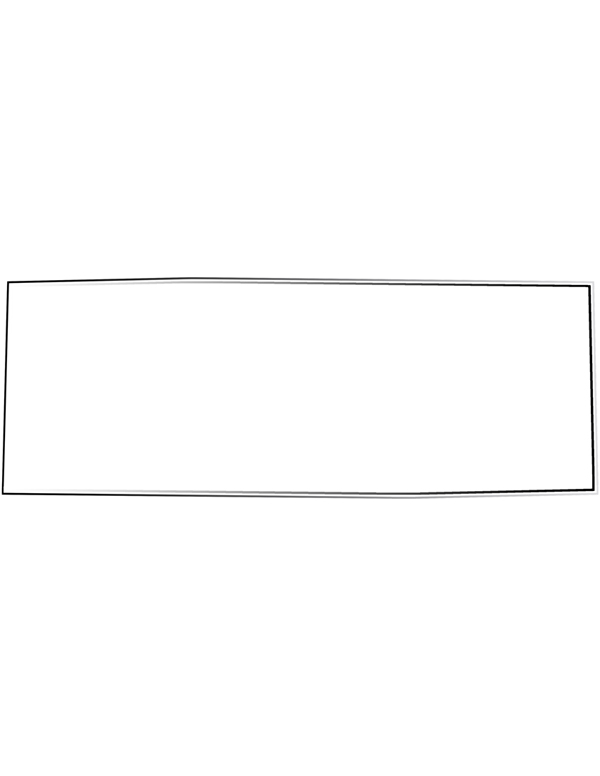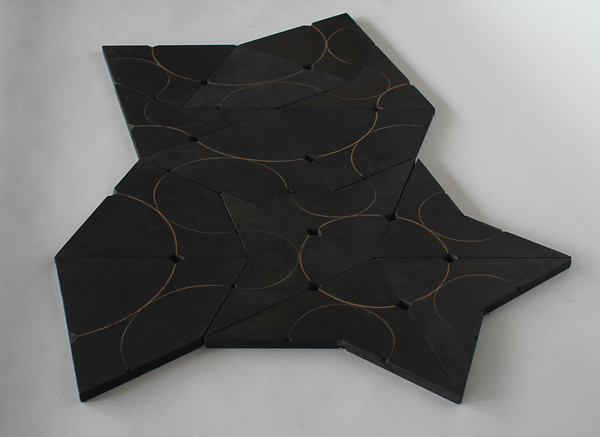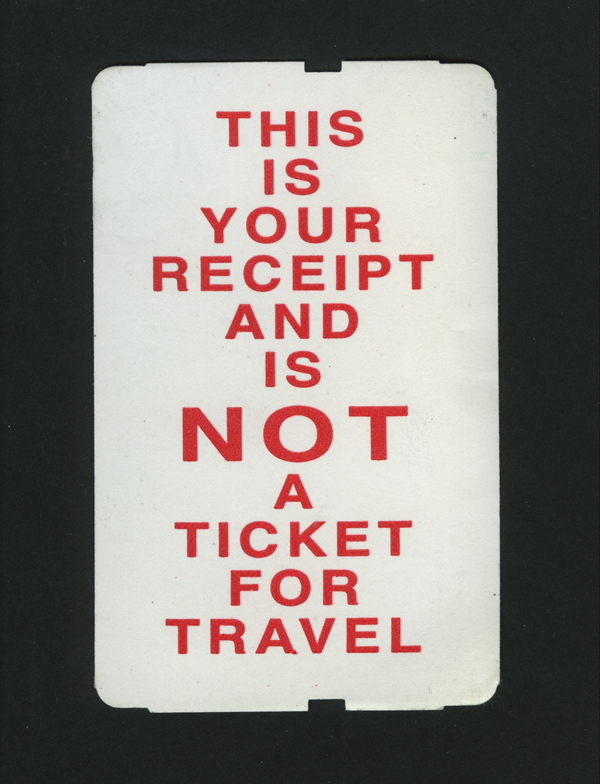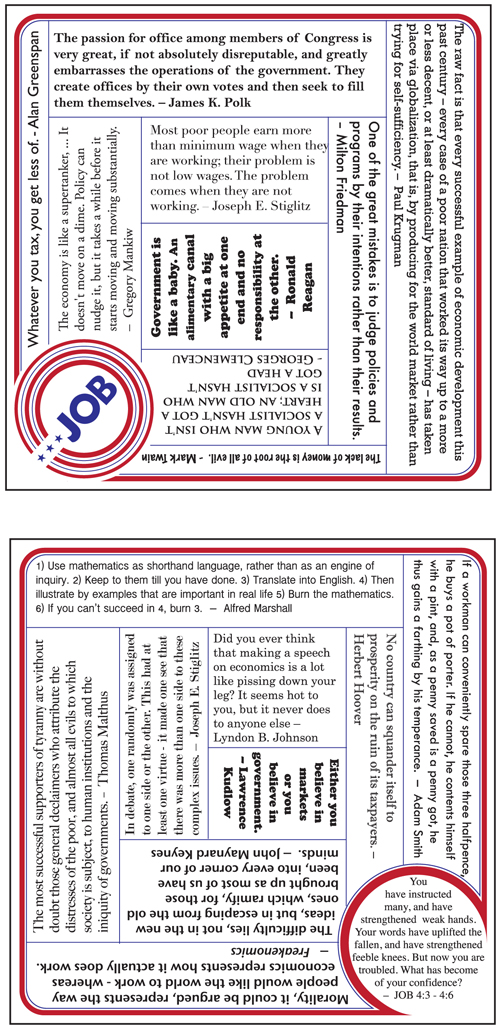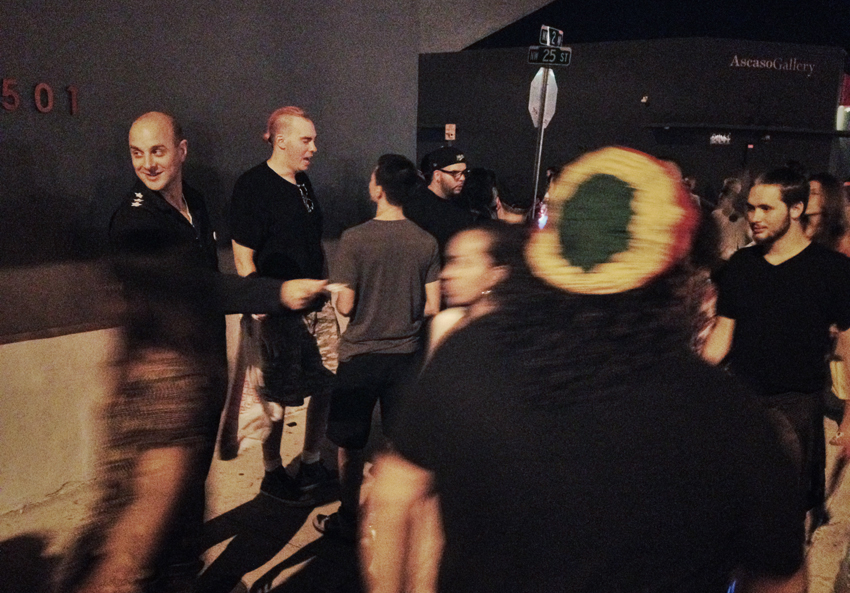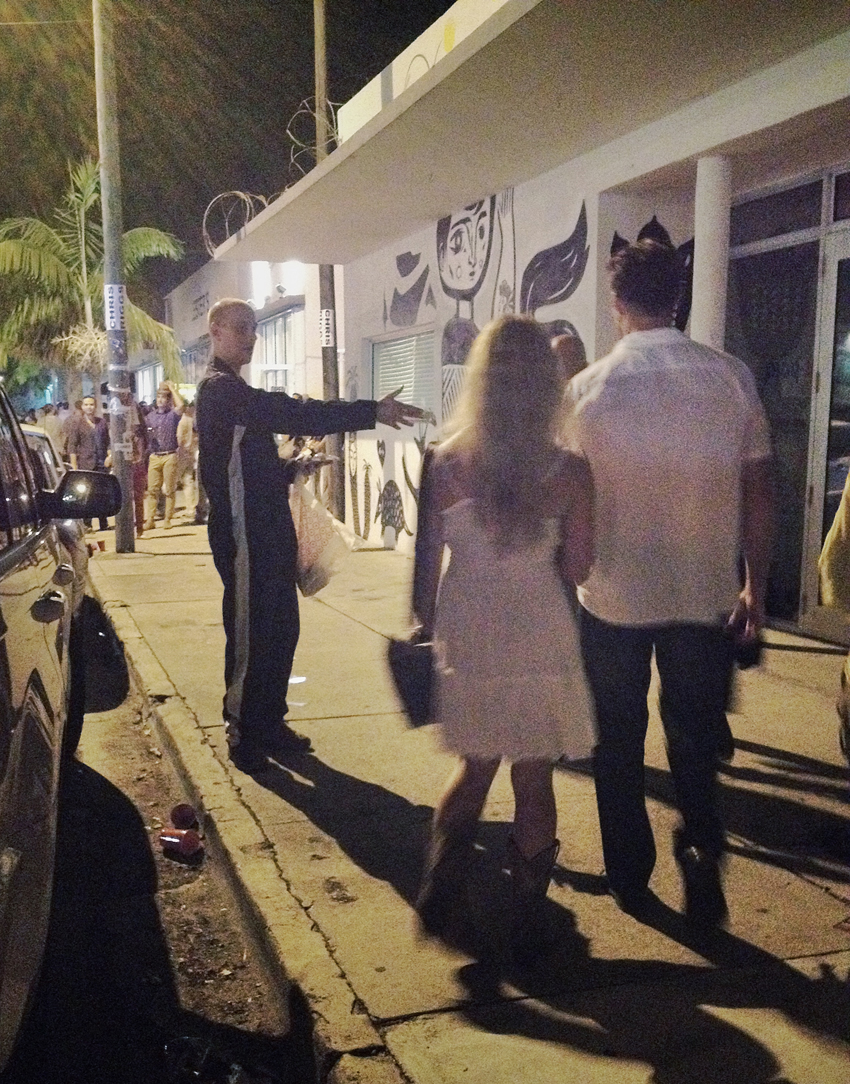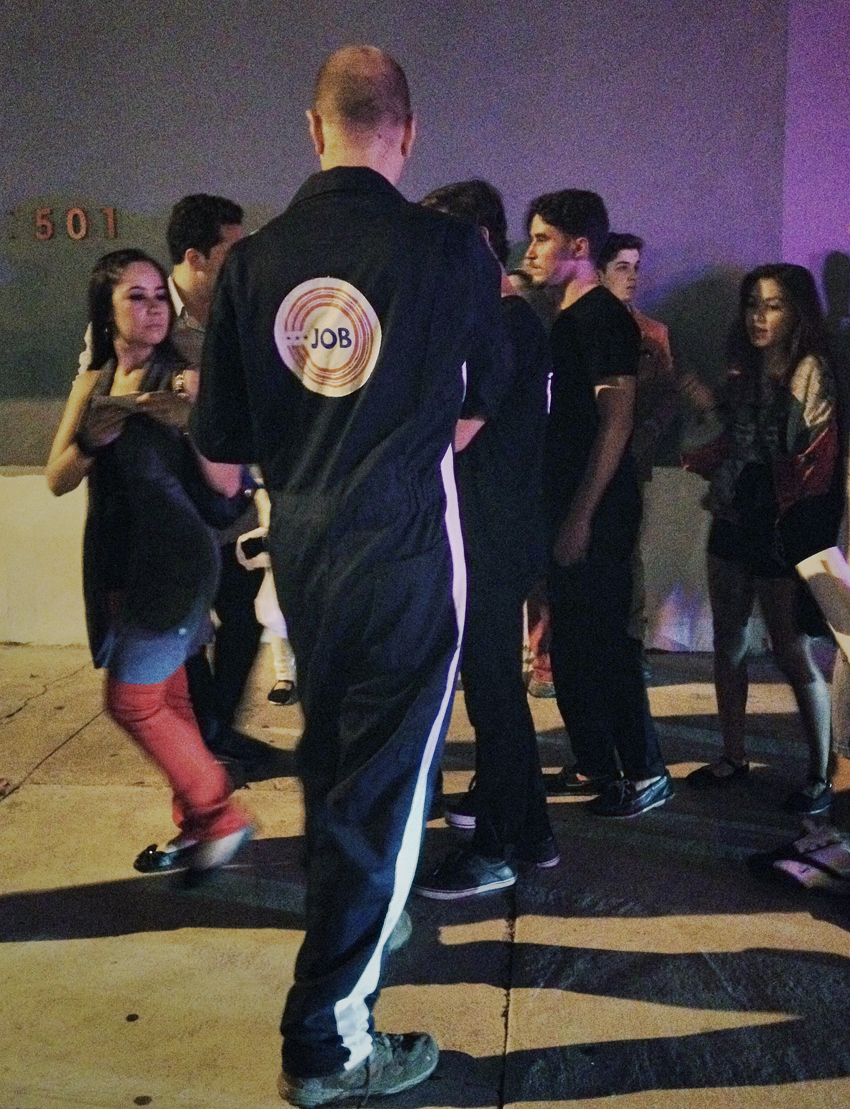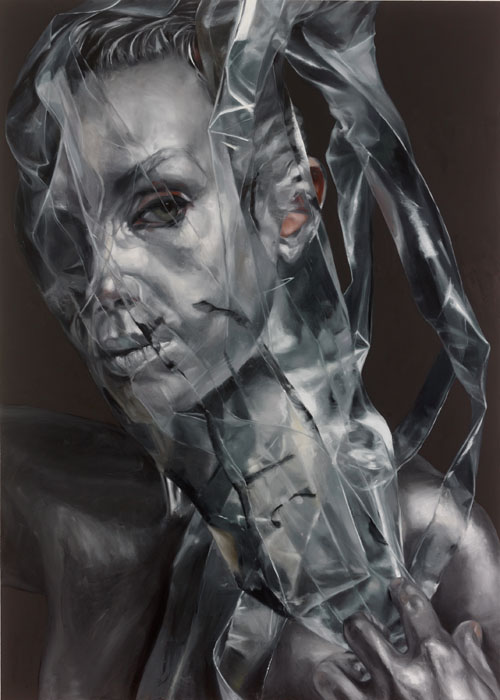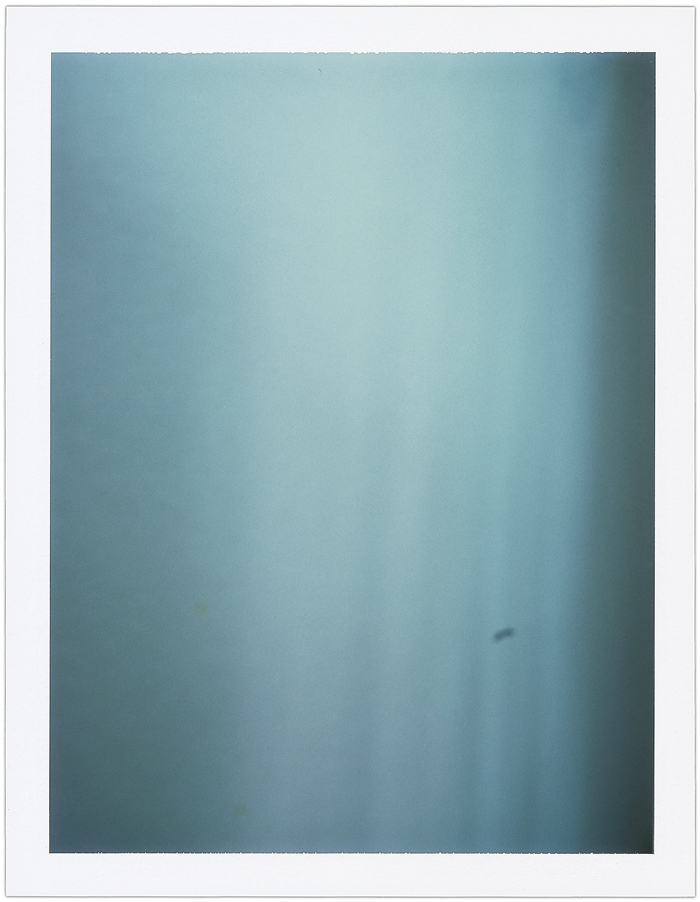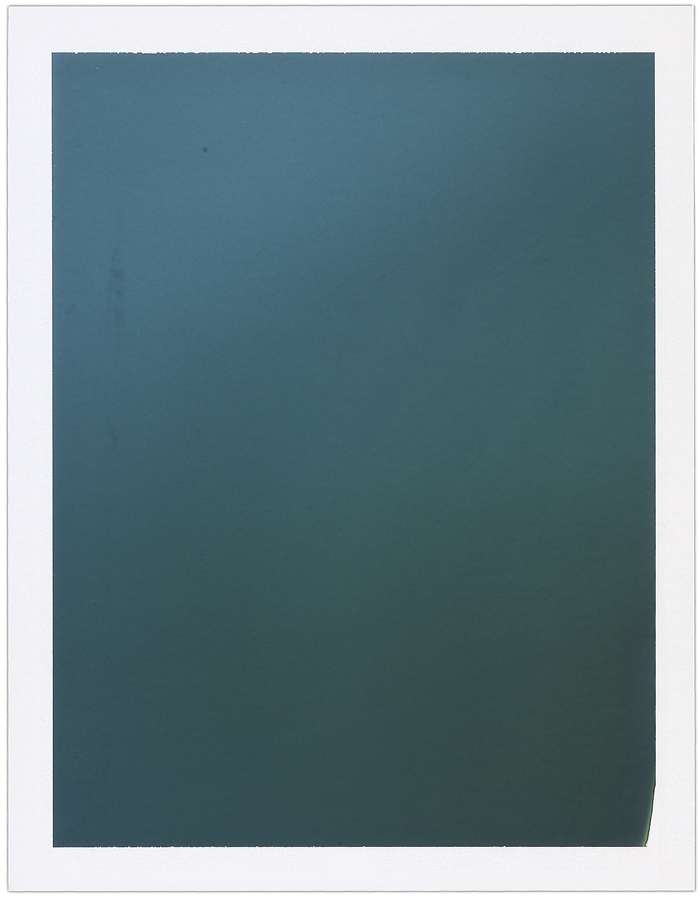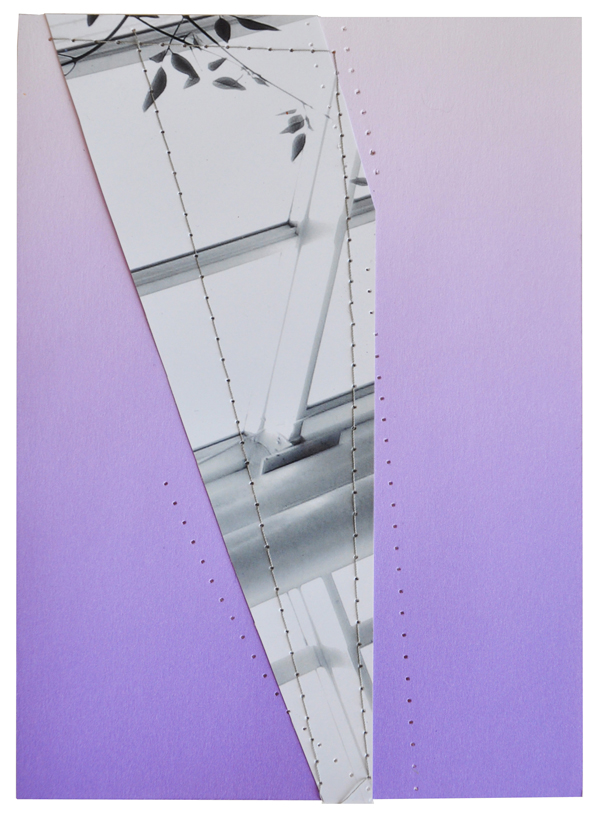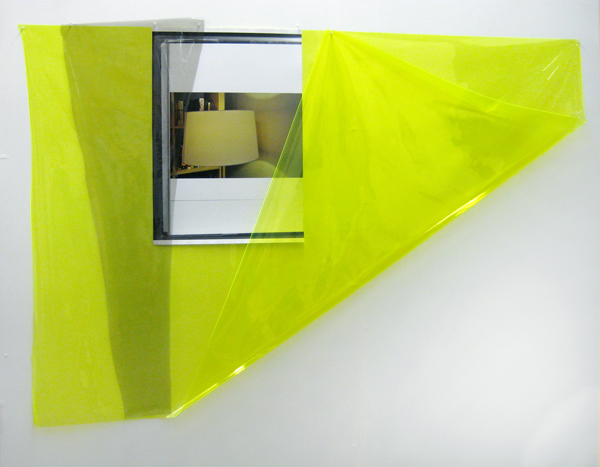01 10
Vol. 01 Issue No. 10
DOWNLOAD PDF: site95_Journal 01_10e
Featuring: André Crespo, Mario Pais, John James Anderson, John Silvis, Agnes Barley, Francesco Longenecker, Jude Broughan, Roberto Carlos Lange, Matthew Brownell, Alexandra Posen, Christian Maychack, Peter Demos, Nils Folke Anderson, Nathan Dilworth, David Schoerner, Laurel Garcia Colvin, Grace Roselli, and Arthur Dove
The October issue marks the first presentation of an exhibition series en- titled “City Limits.” “City Limits” focuses on the influence of the urban environment on contemporary practices. Considering and questioning site-specifity, artists in each exhibition present ideas that are progressive, reactionary, and often poetic with regards to their own urban environ- ment. This special issue features articles and artist projects from writers, curators, and artists to discuss the impact of their environment and how their work is created from inspiration and/or reaction to the culture and politics of their surroundings.
John James Anderson’s solo exhibition at Locust Projects is the first exhi- bition from the series. Anderson’s project based work delves into current topical issues inspired from his home but resonate beyond Washington, DC. The “JOB Creation Project,” for instance, was first presented in Wash- ington, DC at Capitol Hill, Dupont Circle, Gallery Place, Farragut Square, and Union Station. For his exhibition and Journal, Anderson performs the project in the Wynwood District of Miami on a Second Saturday. The different circumstances in terms of setting and audience created a new context for the piece that may at first seem starkly different but in many ways, create similar conclusions and ideas.
The “Dead in August” final exhibition for 2012 is a group show of ten New York based artists whose works revolve around abstraction and the abstracted image. For the Journal each artist was asked to contribute a project based on their own experiences and influences of living in New York City.
My great thanks to everyone involved in this issue including Mario Pais and Paul Schroeder for their contribution on the work of André Crespo and to John Silvis for his own insight on contemporary art practices in New York City. Lastly, thank you so much Chana Budgazad Sheldon, Monica de Miguel, Amanda Sanfilippo, Adam Erickson, Sara Maria Sala- mone, Andrea Hill, Becky Nahom, Danielle Oxford, Jennifer Neff, and Cary Whittier.
More to come, Meaghan
10.08.12 Interview with André Crespo Vila Madalena, São Paulo, Brazil by Mario Pais, edited by Paul Schroeder
I first saw André Crespo’s work while visiting São Paulo in 2001, where he was exhibiting a few pieces from his mono-color collection. I did not have a chance to meet him at the time, but years later I gave him a call from Washington, DC, where I was working as a Public Relations Director for Habatat Galleries. Crespo sent me seven pieces, including “Barra de São João” and “Bom retiro,” which formed his first exhibition in the United States in 2008.
Now in 2012, I am pleased to have the opportunity interview him for site95. Prior to the interview, I walked along the famous artistic Vila Ma- dalena in São Paulo, Brazil where Crespo makes his home. Crespo’s atelier wall is surrounded and ensconced in paintings, and some of his work resides on the common stairway of the Vila.
Our interview was very casual, as Crespo can speak for hours without interruption and is full of energy, as well as a very pleasant person for a conversation that I have transcribed here.
When asked about his background, Crespo explains, “I almost became a professional soccer player but I attended Recreart in 1991 (a drawing school in São Paulo) and was given several screens and paint. My art teacher was Newton Mesquita, a great master of plastic arts in Brazil, who helped me develop my work.”
Day-by-day
Images of people rushing in their daily routines in Crespo’s paintings are really something to be seen. These themes are inspired by his urban life and experiences within his quotidian life and travels. Crespo engages di- rectly to his work, “sometimes I’m the artist, sometimes the character, sometimes both.” Crespo cites a combination of factors for his inspira- tion, but mostly from living over ten years in the most bohemian neigh- borhood of São Paulo, Vila Madalena, where culinary, theater, concerts and parties create a unique cultural nightlife. São Paulo allows bars and restaurants to stay open until the last customer leaves, so it is not unusual to find people stopping at the bakery at 6:00 am for a coffee after a night of partying while others are going to work. It is in this environment that Crespo finds subject matter in his work.
Crespo observes morning buses, rush hour traffic and directly engages with morning commuters. The neighborhood and community around him directly inspire him and he likes to be connected with the people and happenings in his surroundings. When asked what part of the creation process he enjoys the most, Crespo replied that he “likes the pursuit; the action of creating new scenes and new visions, (this) is what keeps me painting.”
Crespo’s phone rang a couple of times during the interview. A collector had to cancel an appointment. Later they called again to re-schedule. I saw two large paintings that he has just finished for a couple of collectors. This is a day in the life of André Crespo, “Everything makes sense in my corner, my house is my atelier. With my wife, I am surrounded by my paintings and my paint, my plants and good wine. It’s good to keep life enthusiastic: to smile and be generous, and treat women with flowers!”
Fragments
In November, Crespo is traveling to Paris for an exhibit at the Grand Pal- ais, where he will be featuring his new collection entitled “Fragmentos do dia-a-dia, (day by day fragments).” It’s his most complete work of city themed paintings; a fury of ideas that crash into every busy corner of the city, reminiscent of a lost memory that he had captured at one point and later resurged. Old sometimes became new and vice-versa. A total of 30 paintings, 16 by 12 inches, are based on these moments to convey the energy of large cities such as Berlin, London, Paris, Barcelona, Lisbon and São Paulo.
André Crespo has exhibited in Washington, New York, the Ca- nary Islands, Lisbon, and London. He will be showing his work in Barcelona in early 2013.
10.23.2012 – 5.1.2013 Feature: “New.NewYork,” Essl Museum, Vienna by John Silvis
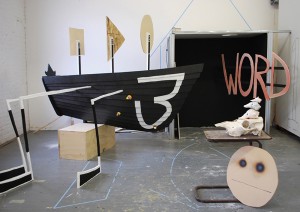
Brent Dickinson, Studio installation view of Systematic Theology, 2012, mixed media, dimensions variable
Does the contemporary New York art scene have a significant influence on the global biennial landscape? The “New.NewYork” exhibition presents nineteen innovative artists who are making a vital contribution to the art world. As a New Yorker of eighteen years, I’ve recently explored emerging art communities in both Beijing and Berlin, which has prepared me to take a fresh look at the work of my peers, most of whom are based in Brooklyn, with eyes for the larger, global context. The sheer geographical density of New York artists, from recent art-school graduates to more established, prolific artists, does not appear to have been influenced by the post-crash market, indicated by the surprisingly competitive housing rental market, which continues to make it difficult for even established artists to secure adequate work space. While statistics indicate that vast amounts of art and money are changing hands in China, the Middle East, and Russia, New York’s complex art world also flourishes because of its unique cross-generational cohesion, which provides a sustaining intellectual exchange to successive generations of young art makers. The notion of this also applies to layers of art professionals and institutions that set incredibly high standards and continually monitor the quality of exhibited work with clarity of vision unmatched elsewhere.
Postwar New York gave birth to major art movements that significantly defined the second half of the twenty-first century, such as Abstract Expressionism, Post Painterly Abstraction, Minimalism, Conceptualism, Pop Art, Land Art, as well as Performance and Video Art. The fertile landscape of New York’s postwar art scene is historically one of the most significant periods in America’s cultural transformation. The energy of that era can also be attributed to New York City’s compact urban layout that encourages a pragmatic and vibrant engagement within its tight geographical boundaries, a characteristic that continues to provide a potent impetus for dialogue. The now-congested city of New York was designed on a grid system, originally proposed by the commissioner of the city in 1811 to ease the flow of commerce and provide more sanitary living conditions. Manhattan’s so-called grid plan had a tremendous influence on the experiential character of the city and still influences our collective awareness of the urban milieu. One can see the grid repeated in the modernist steel and glass buildings conceived by Mies Van der Rohe and translated in the emergence of minimalist painting and sculpture, as found in the works of Agnes Martin and Carl Andre.
For centuries, New York has been permeated by an ethos of discovery and human advancement on all levels of society. Since Marcel Duchamp’s 1913 introduction of a urinal, “Fountain,” as an art object at the first New York Armory show, artistic practice has been infused with the expectation of innovation. The urgency to experience the New in art is a pervasive ambition that fuels all art production and inspires emerging artists to differentiate their work from the canon of art, while thoughtfully acknowledging their artistic lineages. The artists in “New.NewYork” explore the New by either transforming ordinary mass-produced materials into precious, highly considered objects, or by challenging the formal parameters of their respective mediums, which include fiber art, installation, painting, photography, sculpture and video. These pursuits create a fluid interchange of artistic processes that shape ideas into the exciting visual objects seen in this exhibition.
Even a cursory scanning of the “New.NewYork” exhibition will reveal a relative absence of the human figure or other forms of representation. Some of the artists explore their personal histories allegorically by weaving them into their formalist compositions, or by quoting personal narratives as a primary source of inspiration, definitively illustrated in the work of Steven and William Ladd and Brent Dickinson. With the exception of Shelly Silver and Egan Frantz, the artists in the exhibition moved to New York to become active participants in the art world and to build a sustaining community around them. The process of understanding the complexities of art-world networks, combined with the financial struggle to maintain a basic standard of living while having enough time and space to create enduring work is a colossal endeavor. The dedication and resolve of the artists represented here is truly inspiring.
The cultural and intellectual diversity of young artists in New York is unmatched by any other city in the world and consequently encourages artists to set high standards for themselves. And yet, there is an enormous amount of comradery in the New York art world, which willingly shares and disseminates information. As I endeavored to visit seventy-plus studios in preparation for “New.NewYork,” most of the artists in the exhibition gladly introduced me to their peers without solicitation, despite the potential risk of not being chosen to participate in the show. Their comradery extends to the value they place on examining recent intellectual history and building on the ambitions of the generations of artists that preceded them. A poignant example of this is the Minimalist impulse in the works of Sarah Lee and Rob Fischer, who explore a decidedly more humane version of Minimalisim’s historic principles.
Another important characteristic that I considered during the “New.NewYork” selection process was the entrepreneurial quality of the artists’ studio practice. Drawing from many disparate genres and conceptual oeuvres,the artwork that impressed me was rooted in a clear lineage to the important art movements that developed in New York over the last fifty years and translated its ideological essence into compelling contemporary propositions. While not always working intentionally within the trajectory of recent art history, the continuity and thoroughness of artistic vision is quite apparent in their work. For example, the work of Siebren Versteeg aesthetically mirrors the loose brushwork of Abstract Expressionism, while removing it conceptually and physically from that history. Though in some cases the work’s artistic roots are less specific, the objects and images in this exhibition were chosen for their masterful reinterpretation of common materials, a trend that was pioneered by more established artists such as Tara Donovan, who lives and works in Brooklyn.
New York’s vibrancy is firmly grounded in the inter-generational fascination with the new and a concerted willingness by its many patrons to support unchartered artistic visions. At the core of this commitment lies a fundamental belief in the power of human ingenuity and community. New York continues to embody progressive optimism as it welcomes new groups of artists to contribute to the ongoing dialogue of collectors, dealers, critics, art advisors, museums, and artists, which affirms artistic accomplishment by means of complex consensus. Even though the global art world is expanding rapidly, and new centers of influence are likely to emerge over the coming decades (foreshadowed by the recent stock-market crash and China’s surpassing of the United States as the world’s largest art market), the depth and open spirit of the New York art community continues to provide fertile ground for its dedicated participants to flourish.
Exhibition Artists: Jude Broughan, Vince Contarino, Brent Everett Dickinson, Rob Fischer, Ryan Ford, Egan Frantz, Rico Gatson, Robin Kang, Steven and William Ladd, Sarah Lee, Christopher McDonald, Ann Pibal, Lisa Sigal, Shelly Silver, Reid Strelow, Siebren Versteeg, Letha Wilson, and Tamara Zahaykevich.
Artist Projects: Dead in August
Participating artists in “Dead in August” were asked to create an artist project that considered their work and process in the context of living in NYC.
Agnes Barley
Francesco Longnecker
Jude Broughan
Matthew Brownell
Rows of dots emanating out exponentially from window, overlapping less/getting further apart
Row of dots along runner below ads
Rows of dots along top edges of seats
Row of dots surrounding each window on doors
Alexandra Posen
Christian Maychack
Peter Demos
Nils Folke Anderson
Nathan Dilworth
9.08.2012 Artist Project: JOB Creation Project, Miami, Florida by John James Anderson
9.24.12 Featured Artist: Grace Roselli Our Marvelous Punishment, 2012
The title “Our Marvelous Punishment” for this recent series of work is taken from the last stanza in “Voyage” by Tony Hoagland.
“The sea was no longer a metaphor.
The book was no longer a book.
That was the plot.
That was our marvelous punishment.”
External empirical reality, cultural mythologies, gods and monsters vs the human capital of a post-industrial society.
I am fascinated with – and my work engages the space created through that layering of perceptions – what is it to even exist? I am pushing my work practice to use the simplest of means to explore an idea fundamentally unknowable. Primal magic and metaphor combined with a rainy day slog to the subway.
Grace Roselli earned a BFA from the Rhode Island School of Design and received the RISD scholarship to the Skowhegan School of Painting and Sculpture. Roselli completed a residency with the Empire State Studio Program in NYC, then moved to Venice, Italy, studying with Emilio Vedova at the Academy of Fine Arts in Venice. Roselli currently maintains a studio in the “Dumbo” neighborhood of Brooklyn. Recent exhibitions include “Getting From Here to There,” AFP Gallery, “The Last Art Fair,” Northside Festival, “Painting With Pictures 2,” Artjail, and “As Vision Moves Sideways,” The Hole. She has been featured in Hyperallergic, Fine Art Magazine, Artnet Magazine, Metropolitan Home, Village Voice, Time Out New York, The New York Times, Art Matters, Quarto 31 [Columbia University Press], Lusitania Press, among others.
graceroselli.tumblr.com
Artist website: graceroselli.com
9.17.12 Featured Artist: Laurel Garcia Colvin
In the practice of my art I explore what it is to be a human in this world, both individually and collectively. I am interested in how the human psyche perceives and constructs reality, subjective experiences, illusion and disillusion. I render narrative figurative images, often in a fragmented way, to evoke emotional, psychological, or spiritual states and suggest human vulnerability when facing the discrepancy between desires and reality.
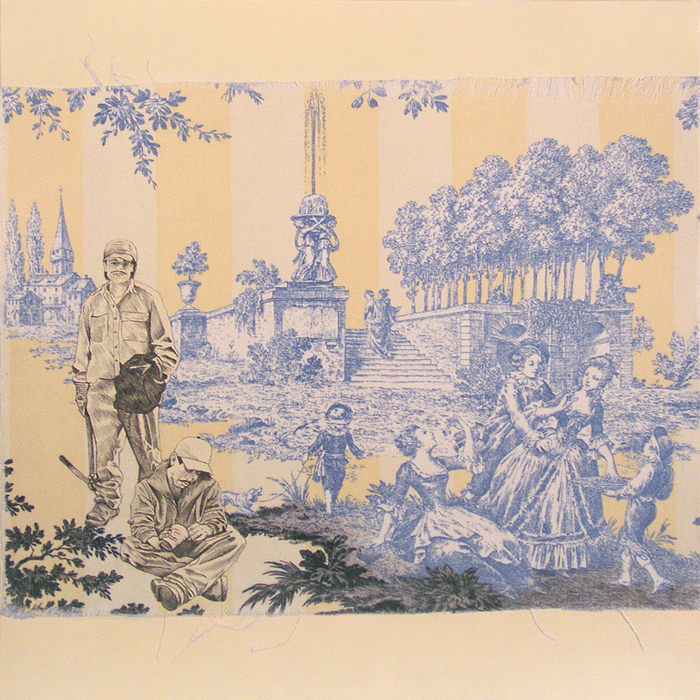
The New American Toile Remnant (day laborers), 2010, graphite and gouache on fabric mounted on paper, 16 x 16in
My recent work of mixed media drawings on fabric mounted on wood panels (“The New American Toile” series), fabric remnants (“The New American Toile Remnants” series) mounted on paper, and prints (“The Vignette” series) of drawn vignettes use the French 18th century designs of Toile de Jouy as the starting point. I juxtapose the background printed fabric narrative of a pastoral past populated by idyllic figures with a foreground of contemporary situations. Homelessness, gun violence, and other current controversies are in direct contrast to the nostalgic, sanitized, leisurely decorum of these historical toile patterns. The overlay of silhouettes and detailed renderings of figures inhabiting this fragmented world create visual commentaries on the contradictions, changes and complexities of contemporary life. With undertones of foreboding, wanting and dismay, these works delve into the world of reality and fantasy, and provide a visual space to reflect on and reconsider the relationship between what remains, what is scrapped and what is made new in society’s collective consciousness.
Laurel Garcia Colvin’s work has exhibited in solo and group shows in several galleries throughout the United States and abroad and had a recent residency at the Constance Saltonstall Foundation for the Arts, Ithaca, NY. Garcia Colvin received her BFA and MFA from the University of Texas at Austin, and did post-graduate studies at Pratt Institute. Upcoming exhibitions include: “25,” Target Gallery, the Torpedo Factory, VA (September 8 – 30), Artists Wanted Gallery, Long Island City, NY (September 17 – October 18), “The Ballot Box,” BRC gallery, Peekskill, NY (October 15 -November 24), and the Saratoga Arts Center, NY (Fall, 2014). She lives and works in Chappaqua, New York.
Artist website: laurelgarciacolvin.com
9.10.12 Featured Artist: David Schoerner Studio Polaroids, 2012
A sheet of 4×5 instant film exposed each day I am in the studio for the duration of time I am there.
In January 2012, I began making instant film prints. One is made each day that I go to my studio to work. Upon entering my studio I point a 4×5 view camera directly at one of the walls, set the aperture to its maximum, and expose a sheet of 4×5 instant film for the duration of time I am there. I then develop the print just prior to leaving the studio. The resulting image is a field of color – a kind of document of color temperature and my time spent working in the studio. Subtle variations of light and dark, with hints of texture from the wall, create a depth to the photographic prints. They become a sentimental record of the artist’s time spent working alone in the studio. With this realization the subtleties of color and light take on new meaning and importance, and the viewer is left to contemplate the simultaneous intimacy and isolation of a camera working independently in the studio while I do the same.
Born in 1984, David Schoerner lives and works in New York. He has exhibited nationally and internationally, most recently his work was included in an exhibition at Higher Pictures, organized by Artie Vierkant. Solo exhibitions of his work have been on view in Oslo, Norway at MELK Galleri, The Carol Schlosberg Gallery, Montserrat College of Art, Beverly, Massachusetts, and a forthcoming solo exhibition (2013) at Texas Tech University, Lubbock, Texas. He is the founder of Hassla Books.
Artist website: davidschoerner.com
9.3.12 Featured Artist: John James Anderson
DC Murders 2006-2010: A visual timeline of homicides in the Nations Capital
For the months of September and October, Locust Projects is partnering with the roving curatorial initiative site95, who will present the first installment of their multi-city series City Limits in the Project Room. The exhibition consists of three projects by the Washington, DC-based artist John James Anderson. Organized by curator and site95 founder Meaghan Kent, the series focuses on the influence of the urban environment on contemporary practices. Considering and questioning site-specifity, artists in each exhibition present ideas that are progressive, reactionary, and often poetic with regards to their own urban environment.
Anderson’s projects engage current cultural and political issues that are endemic to, but resonate far beyond, Washington, DC. For “Maintenance Required,” the artist mapped broken fire hydrants throughout the city, spurred into action by hydrant failures during the 2007 Eastern Market and Georgetown Library Fires. For “Hours of Labor,” the artist investigates the current politics of economics and immigration by hiring day laborers to create objects with him. The installation juxtaposes the tools and objects with documentation from his conversations and experiences with the laborers. “JOB Creation Project” is an effort to inspire ideas for job security. For this performative action, Anderson disseminates literature in the form of buttons and quote cards that will be on view in the gallery. Further documentation of the performance will be featured in the site95 October Journal.
In conjunction with the Project Room exhibition, Anderson’s work will be featured on over 30 bus shelters around Miami in September 2012 for the Bus Shelter Project, part of Locust Projects’ public art initiative “Out of the Box,” which commissions artists to create new work for public spaces in Miami.
Originally from Iowa, John James Anderson has lived in Washington, DC for the last eight years, completing an MFA in painting at American University in 2005. His work has been exhibited at Corcoran Gallery of Art and Washington Project for the Arts in Washington, DC; Arlington Arts Center in Virginia; and Adah Rose Gallery in Maryland. Anderson was a fellow for the DC Commission on the Arts and Humanities, Washington DC, in 2010.
Feature: Looking at the work of Jude Broughan through the eye of Arthur Dove’s needle by Meaghan Kent
The history of collage and its connections to New York City are manifold. In a city where you can find just about anything you want, whenever you want, making mixed media objects would be ideal. Moreover, the political and cultural issues circulating throughout the metropolis present the collage as a unique paradox between man and machine. Modernity in the urban environment can ignite inspiration.
Arthur Dove’s “Hand Sewing Machine” (1927) was influenced by and reacting to New York City’s industrial movement. The dynamic collage would seem atypical of his work; Dove is known primarily for his abstractions where the intention was to shift from materialism and concentrate more on nature. He had a close friendship with artist and dealer Alfred Stieglitz and both “shared a critical attitude toward the materialism of American life and a belief that the conventional art of their time was inadequate to the expression of contemporary values.” (I)
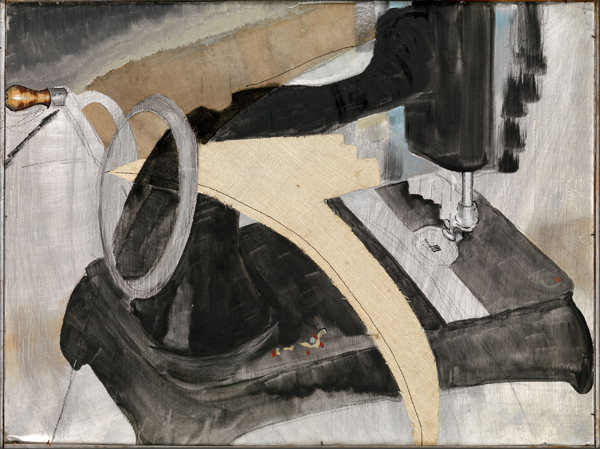
Arthur Dove, Hand Sewing Machine, 1927, Oil, cut and pasted linen, resin, and graphite on
sheet metal, with artist made frame, 14 x 19.75in, courtesy of The Metropolitan Museum of Art
While showing his work at Stieglitz’s galleries, Dove worked on and off as an illustrator in New York City. He would leave the city several times in his lifetime; first to Europe in 1907, next to the suburbs of Westport, Connecticut with his first wife in 1909, and then in 1920 to a houseboat on the Harlem River (and later Long Island) with his second wife, painter Helen Torr. (II) Leaving the city proper, he sought nature; which led him to non-representational work that he coined as extraction. (III)
On his boat, he made 25 known collages. (IV) The use of material was both critical and playful. In a sense, he was still extracting; but this time, he was reinterpreting found objects and materials. He was using everyday items: sandpaper, tape measures, cardboard, wood, and making them become something else. In many cases these paintings were made as portraits of friends and neighbors, symbolic attributes with humorous undertones. (V)
“Hand Sewing Machine” is a reflection of a mass produced object that replaces the individual craft. The whirl and painterly brushstroke in the upper right corner of the painting reads like the pulse of the speed of a locomotive. On the left side, the crank on the handle of the machine almost completely disappears into the background. The play off the title “Hand Sewing Machine” nods to the human interaction with technology and modernity. Industrial materials including linen, resin, and graphite on sheet metal (aluminum) are brought together in a tongue-in-cheek fashion. The power of the piece is indicative of the influx of industrialization and most likely the growth of the garment district (only a few blocks north of Stieglitz’s 291 Gallery and southwest of The Intimate Gallery). To give further context: this is also the same year that Fritz Lang’s “Metropolis” opens in Germany. The uncontrollable force of post-industrialism was realized and openly critiqued.
Dove was influenced by Cubism as a result of his travels through Europe and his friendship with Stieglitz. Through his relationship with Stieglitz, he met artists in New York City working with mixed media, including Duchamp, who had just completed “The Large Glass” in 1925. He was also around the avant-garde portraiture by Marsden Hartley and Charles Demuth and well aware of the American folk art revival. (VI)
The extensive history of collage is widely varied. For Dove, collage and mixed media artwork were something with which he was not unfamiliar but were instead something he wanted to utilize. Through the use of the everyday object, Dove was able to create a narrative that appreciates the traditions of folk art and realizes the dangerous potential of the machine. Paul Thek, Al Hansen and Robert Rauschenberg (all artists living in New York for periods of time) would later use collage, or Assemblage, to emphasize the use of the printed word in modern society, to react against traditional painting, or to serve as props or studies for their performative actions in the 1960s.
As technology shifted from machine making to digital work, the use of collage has had similar effects, almost a hundred years later. Works are most often fabricated and made by machines – almost completely losing their tactile qualities in favor of a highly finished output.
In many ways, Jude Broughan’s work embraces the mechanics as a means of recognizing the excessiveness of digital images and utilizing the power, repetition, and consistency found in machinery. Broughan, born in New Zealand and living in Brooklyn, creates wall-based work that shifts from two to three-dimensionality. Broughan’s inspired use of digital prints with natural and synthetic materials works off the environment around her.
For Broughan:
(My work) embodies my immediate experience of the environment of New York, the concrete and human jungle. My palette shifts from the greys and greens of the city’s buildings and trees to hues that evoke the light of other climates—the minty green of New Zealand’s state houses or the glow of southern hemisphere sunshine through orange curtains—locating myself through a process of understanding one place, one time (and, by extension, one state of being) through allusion to countless alternatives. (VII)
“Untitled,” 2012 juxtaposes a black and white print that has been cut in a jagged shape and stitched to lavender colored paper. The cool solid color against the image of light creates a contrast of positive and negative space. The jagged shape of the print in “Untitled” becomes pure form and has a similar sensibility to the linen fabric in Dove’s “Hand Sewing Machine.” Both shapes aim downward through the middle of the picture plane and spill off of the canvas. The framing of the irregular shape in “Untitled” is reiterated with the stitching across the paper and print as if to mimic the irregularity of lines in the image itself. The process of sewing, a monotonous repetition, becomes part of the picture and creates its own forms and patterns with the punched holes and lines.
Broughan culls images from various sources including vintage cookbooks, gardening and library books, or her own photography ranging from her daily routines to traveling.
There are themes that run throughout recent projects, one of the most important being a critique of the role of photography as a visual dialect associated with commercial culture. The images I produce are openly flawed and ambiguous, so that viewers anticipating the seductive surface of conventional ‘high-end’ photography might feel stymied at first. Displacing the promise of closure is a palpable tension between private and public, between ‘full’ and seemingly empty space.
“Bookcase” is a juxtaposition of an interior setting intertwined in folds of vinyl fabric and plastic Broughan had acquired in Chinatown. The books on the shelves suggest current perspectives on printed materials as everything now shifts to the digital era. The image itself reveals the marks of the scan and becomes even more blurred under a filtered shard of plastic. Broughan has worked with collage for several years, she writes:
I have always used elements of collage, if not always in finished works, then in sketchbooks and experiments. Recently, vinyl and plastics have been my main ‘fabrics’; they really push the sewing machine to its limit.
Broughan’s work is a hybrid of approaches that shifts from machine to handmade and back again. Much like in Dove’s title and painting – the “hand” element comes into play by operating machinery to create the object but disappears in the final output.
In general, my work combines the languages of photography, painting, printmaking, and collage. I juxtapose photographic prints with physically constructed elements, aiming to achieve a feeling of immediacy and provide different points of access for the viewer. The results are presented as intimate improvised conversations around perceptions of the quotidian.
With collage, there is an idea of placing the materials and objects to create a cohesive piece. The feeling of intimacy in Broughan’s work can be attributed to her choice in imagery and the domesticity of the personal sewing machine. There is a flow with the punctured marks, layers, and textures in Broughan’s work, a kind of poetry in the rhythm of the machine.
Jude Broughan is an artist based in Brooklyn, New York. See contributors section. judebroughan.com
I Morgan, Ann Lee, Arthur Dove: His Life and Work with a Catalogue Raisonne (Newark: University of Delaware Press, 1984)
II The Phillips Collection, The Eye of Duncan Phillips, Yale University Press, 1999, 398
III Morgan, Ann Lee, Arthur Dove: His Life and Work with a Catalogue Raisonne (Newark: University of Delaware Press, 1984)
IV Phillips Collection, “Huntington Harbor I, 1926,” phillipscollection.org/research/american_art/artwork/Dove-Huntington_HarborI.htm
V Metropolitan Museum, “Portrait of Ralph Dusenberry,” metmuseum.org/toah/works-of-art/49.70.36
VI Phillips Collection, “Huntington Harbor I, 1926,” phillipscollection.org/research/american_art/artwork/Dove-Huntington_HarborI.htm
VII All indented quotes are from an email interview with Jude Broughan, September 5, 2012
Additional Sources:
Todd, Emily Leland, “Pieces of Experience Literally Seized: Arthur Dove’s Symbolic Portraits in Collage, 1924-25,” Rice University, 1988
Wilson, Kristina, “The Intimate Gallery and the Equivalents: Spirituality in the 1920s Work of Stieglitz,” The Art Bulletin, Vol. 85, No.4, December 2003,
746-768.
